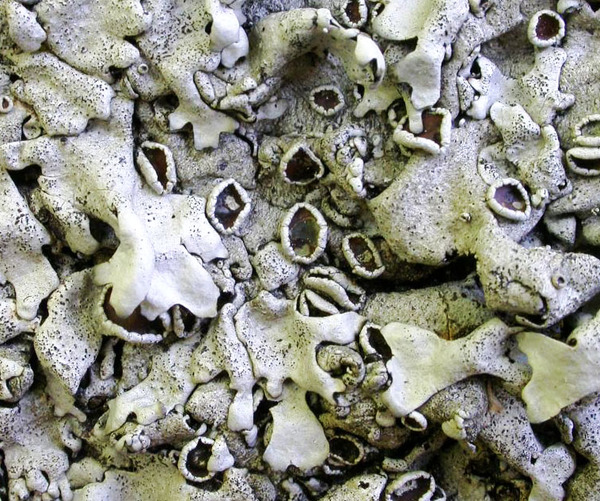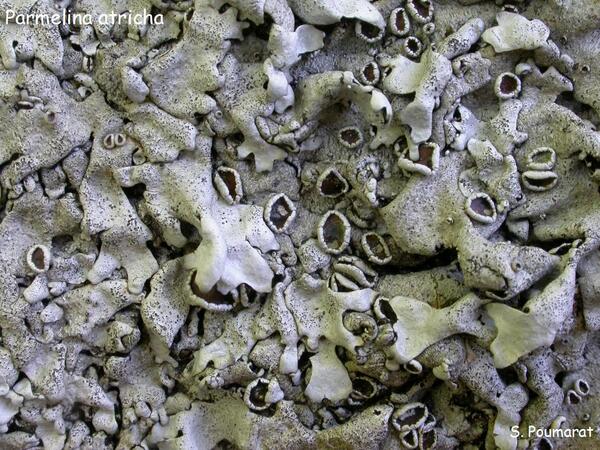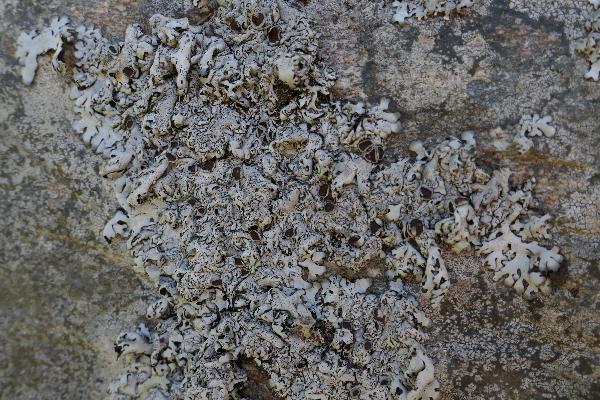Parmelina atricha (Nyl.) P. Clerc
in Clerc & Truong, Sauteria, 15: 185, 2008. Basionym: Parmelia atricha Nyl. - Bull. Soc. linn. Normandie, sér. 2, 6: 271, 1872.
Synonyms: Parmelia quercina f. saxicola (Körb.) Zahlbr.; Parmelia quercina var. convoluta (Schaer.) Zahlbr.
Description: Thallus foliose, heteromerous, dorsiventral, loosely adnate, forming 3-10 cm wide rosettes, the central parts becoming more or less panniform, being covered by numerous overlapping lobules. Peripheral lobes 2-3 mm wide, dichotomously or irregularly branched, usually deeply incised, at first contiguous, but soon overlapping, flat to slightly concave, the tips more or less rotund and crenate, epruinose, with short, black marginal cilia most frequent along the characteristically rounded axils; central lobules 1-2 mm wide, irregularly or dichotomously branched, epruinose, flat to distinctly convex. Upper surface pale mineral grey, emaculate, smooth, often more or less shiny; lower surface black in central parts, brownish in marginal parts, shiny, with dense, 0.8-2 mm long, thin, simple, 0.8-2 mm long, black and shiny rhizines. Upper cortex of tightly packed, anticlinally oriented hyphae, with a pored epicortex, the cell walls with isolichenan; medulla white; algal layer continuous; lower cortex paraplectenchymatous, with rounded and thick-walled cells. Apothecia common, lecanorine, 2-3(-5) mm across, with a red-brown disc and a thick thalline margin with distinctly wrinkled lower surface bearing no or few rhizines. Epithecium brownish; hymenium and hypothecium colourless. Asci 8-spored, clavate, the K/I+ blue tholus penetrated by a faintly amyloid apical cushion with parallel or diverging flanks, the wall K/I-, surrounded by a K/I+ blue outer layer, Lecanora-type. Ascospores 1-celled, hyaline, ellipsoid, 8-11 x 5-7 μm. Pycnidia black, usually numerous. Conidia bacilliform, straight, 5-7 x c. 1 μm. Photobiont chlorococcoid. Spot tests: upper cortex K+ yellow, C-, KC-, P- or P+ faintly yellow; medulla K-, C+ red, KC+ red, P-, UV-. Chemistry: upper cortex with atranorin; medulla with lecanoric acid (major), and gyrophoric acid (minor).
Growth form: Foliose, broad lobed
Substrata: rocks
Photobiont: green algae other than Trentepohlia
Reproductive strategy: mainly sexual
Commonnes-rarity: (info)
Alpine belt: absent
Subalpine belt: absent
Montane belt: extremely rare
Dry submediterranean belt: extremely rare
Humid submediterranean belt: absent
Padanian area: absent
pH of the substrata:
1 2 3 4 5
Solar irradiation:
1 2 3 4 5
Aridity:
1 2 3 4 5
Eutrophication:
1 2 3 4 5
Poleotolerance:
0 1 2 3
Altitudinal distribution:
1 2 3 4 5 6
Rarity
absent
extremely rare
very rare
rare
rather rare
rather common
common
very common
extremely common
Loading data...
Occurrence data
Predictive map
Growth form: Foliose, broad lobed
Substrata: rocks
Photobiont: green algae other than Trentepohlia
Reproductive strategy: mainly sexual
Commonnes-rarity: (info)
Alpine belt: absent
Subalpine belt: absent
Montane belt: extremely rare
Dry submediterranean belt: extremely rare
Humid submediterranean belt: absent
Padanian area: absent
pH of the substrata:
| 1 | 2 | 3 | 4 | 5 |
Solar irradiation:
| 1 | 2 | 3 | 4 | 5 |
Aridity:
| 1 | 2 | 3 | 4 | 5 |
Eutrophication:
| 1 | 2 | 3 | 4 | 5 |
Poleotolerance:
| 0 | 1 | 2 | 3 |
Altitudinal distribution:
| 1 | 2 | 3 | 4 | 5 | 6 |
Rarity
absent
extremely rare
very rare
rare
rather rare
rather common
common
very common
extremely common
Loading data...
Occurrence data
Predictive map









